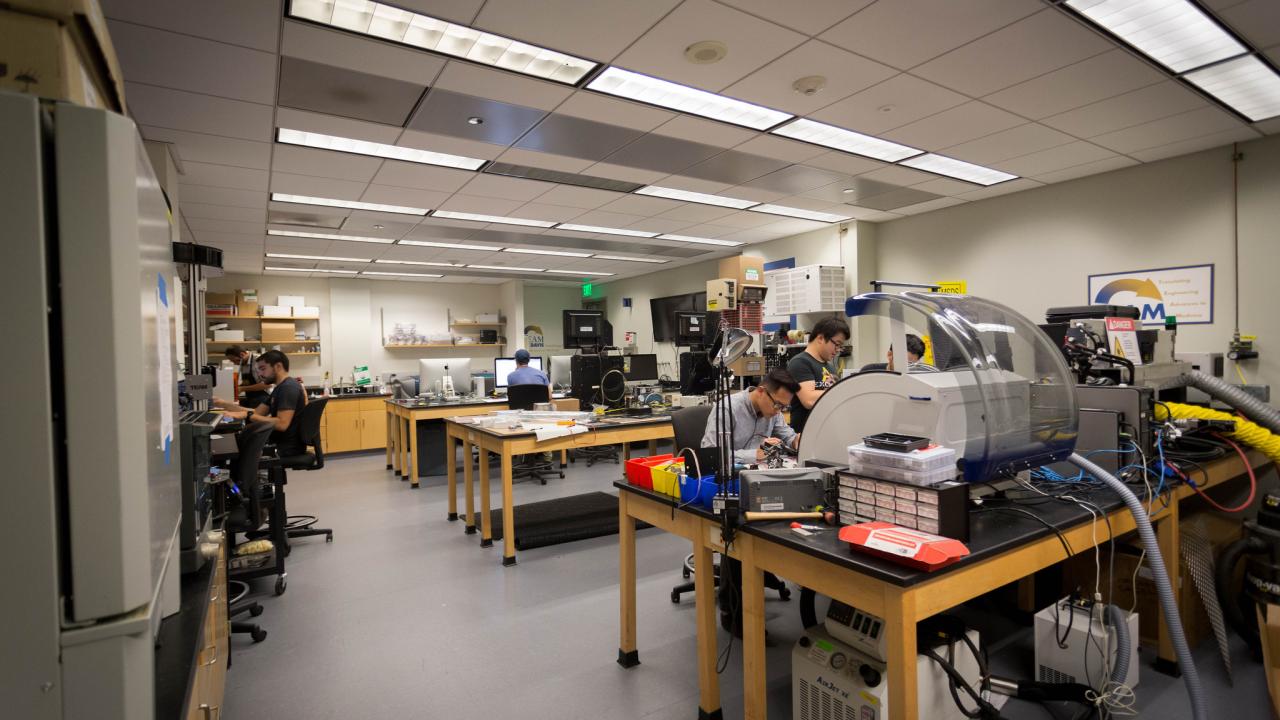
Taking tech to heart
First, a replica of your heart that a doctor can hold in her hands. Next, a living sensor inside your phone that detects nearby pollutants or pathogens. That’s TEAMwork. Their motto is “What can we help you make?”
In 2016, the Translating Engineering Advances to Medicine (TEAM) laboratory made news by printing a three dimensional heart for a pediatric cardiothoracic surgeon. Adapted from pre-surgery planning for veterinary patients, the plastic organ allowed the doctor to examine the peculiar structures of his 19-month-old patient’s heart and strategize for a safe operation. Similarly, the handheld electromagnetic “pod,” a new project helping define novel “hybrid devices,” is poised to make our interactions with the environment and each other safer and healthier. Principal Development Engineer in the UC Davis College of Engineering and TEAM Assistant Director Jerry Hu eagerly answered our questions about TEAM’s many contributions to One Health work.
Department of Biomedical Engineering (BME): Besides the heart, what body parts has TEAM printed, and what medical conditions did those parts address?
Jerry Hu: We have printed out mandibles (jaw bones) for both humans and animals. We have printed femora (thigh bones) to help correct deformities, the bones of the wrist to help correct improper healing, and even soft tissues. For example, ears have been printed to form prosthetics, and we print stomachs after reduction surgeries to help the surgeon appreciate the change in volume more easily. After a patient undergoes surgery to reduce the volume of her/his stomach for weight loss purposes, the volume of the stomach can expand back over time. A 3D printed stomach would not only help the surgeon quickly see how much volume has returned but can also be easily understood by the patient and even by students for training purposes.
Another example is printing out boluses for radiation therapy. Since 3D printing occurs by layer-by-layer deposition of materials to form the final shape, materials beside plastic can be incorporated into the layers while the bolus is formed. Thus, we can incorporate steel plates or radio-opaque materials to provide shielding during radiotherapy.
BME: What do you make of TEAM at its two-year anniversary?
Hu: TEAM is still growing, in terms of both clients and services. To give an example, over TEAM’s first year, pre-surgical planning was developed for veterinary patients. In 2016, pre-surgical planning expanded to human patients. TEAM has also been undergoing renovations, which are scheduled to be complete in March of 2017. Completion of remodeling would bring the electrical-mechanical prototyping and the molecular-biological prototyping facilities adjacent to each other, thereby accelerating the prototyping of what we call “hybrid devices.”
Hybrid devices incorporate biological, electrical and mechanical components together. As an example, we are already working with a client on adding molecularly modified nucleotides (e.g., DNA, RNA) to an electrical-mechanical device for detecting pathogens, and we are looking forward to using modified cells instead in the future. Imagine a little pod containing bacteria or some other living sensor, which you can plug into your phone, that you can wave around in the air to detect pollutants or pathogens; this is an example of hybrid devices that we believe are coming in the near future.
BME: What’s happening today to make the tools TEAM creates more accessible or available to human and veterinary health professionals?
Hu: Our website is an easy way to submit service requests.
We are also seeing it spread via word of mouth, with TEAM being so entwined into the educational experience of our undergraduates, from their first days at UC Davis until their senior design projects. An example is the recent, annual Make-a-Thon, which attracted participants from universities all over California. Students who have used TEAM’s facilities end up telling the faculty for whom they do research about our capabilities, and we are grateful for this.
BME: What makes TEAM so impactful?
Hu: Other than recharge services, TEAM works pro bono for service members and through education. We offer commercial grade equipment and a plethora of services, including consultation services and CAD development. For example, private individuals and start-up companies often have limited CAD experience. We have printers that form shapes with interlocking parts or with articulation, printers that allow for objects containing parts of different stiffnesses, and printers that are faster or give finer detail. Clients generally have no experience optimizing the 3D prints or selecting which printer/printing method would be appropriate for their application, and we provide consultation on these, too.
It is important to note that the molecular-biological prototyping aspect is completely novel and not at all what would be available in most prototyping facilities. Just like the electrical-mechanical side, we also offer design services on the molecular-biological side. In short, the scale of our prototyping capabilities span from molecules to machines!
BME: I’ve heard that biomedical engineering applications can be used in the social sciences and fine arts. How can this be true?
Hu: We can potentially help the university’s anthropology department by scanning in paleoanthropological samples that they have in their collection to help them collect morphometric data or, at the minimum, to give them digital back-ups of fossilized remains. Artists can make sketches, but what about sculptors? We can help artists scan in their sculptures to create digital back-ups of their work, even while it is being formed – imagine if Andy Warhol, who has been described as a hoarder, had access to digital hoarding, how differently we would be able to study his legacy!
Our clients include all disciplines in engineering, veterinarians and surgeons, as well as researchers and clients from outside the university. We are looking to expand our services to others as well. TEAM can prototype much more than objects for scientific research.
Read the original article on UC Davis’ One Health blog.
